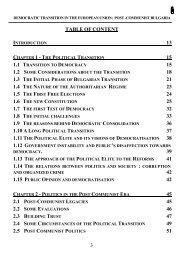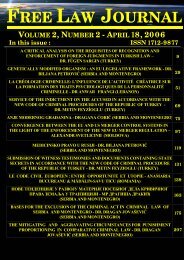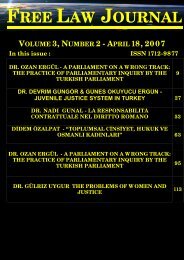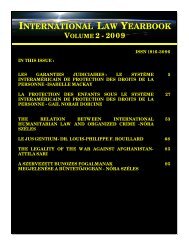Free_Law_Journal-Vol.. - Free World Publishing Inc.
Free_Law_Journal-Vol.. - Free World Publishing Inc.
Free_Law_Journal-Vol.. - Free World Publishing Inc.
Create successful ePaper yourself
Turn your PDF publications into a flip-book with our unique Google optimized e-Paper software.
FREE LAW JOURNAL - VOLUME 1, NUMBER 1 (18 JULY 2005)<br />
But an exception is accepted to this rule and that is if the claim is expressly limited to a specific basis and<br />
if the reason of the action is clearly shown in the formula of the action 45 .<br />
However in personal actions, a different obligation arises from each relation. For example, the plaintiff<br />
brings an action claiming an amount of money, basing on a sale contract and he loses this action, then he<br />
can demand the same amount of money, by bringing a new action basing on a loan agreement this time,<br />
without encourtering any legal obstacles 46 . So the system of ipso iure destruction is used only where the<br />
notion of novatio is possible that is in personal actions with formulae in ius 47 .<br />
One of the simplest example that can be given to explain the scope of bis de eadem re ne sit actio<br />
principle is like this; “the plaintiff, brings an action against the defendant. After conclusion of joinder of<br />
issue phase of the formula, it becomes impossible for the plaintiff, to bring the same action once again on<br />
the same contentious issue either by ipso iure, or by an exceptio rei iudicata vel in iudicium deductae 48<br />
which is brought forward by the defendant. But the scope of bis de eadem re ne sit actio principle should<br />
not to be considered too narrow as in the example given above. Otherwise it would be impossible for this<br />
principle to reach its aim. The concept of “same action”, must be considered on a large scale. In some<br />
cases, bis de eadem re ne sit actio principle becomes meaningless, allowing to bring another action,<br />
serving the same purpose with the first action. For this reason, if more than one action exist targetting the<br />
same purpose or if more than one plaintiff can bring an action against one defendant, bis de eadem re ne<br />
sit actio principle should be applied 49 .<br />
Bis de eadem re ne sit actio principle is not applied to a plaintiff in cases where he brings an action of<br />
replein against a defendant, against whom, he brought forward an interdictum 50 or a condictio 51 about the<br />
same contentious issue. That is because, interdictum is about possession and rei vindicatio is about<br />
ownership 52 . In these cases it can not be accepted that the same demand is claimed. But, bis de eadem re<br />
ne sit actio principle is accepted in cases where actio redhibitoria 53 and actio quanti minoris 54 are brought<br />
45 D. 44, 2, 11, 2, 14; D. 44, 2, 14, 2.<br />
46 Burdese, A.; Manuale di Dirirtto Privato Romano, Turin 1964, p.115 sq; In Roman law of procedure, no general action<br />
exists. This means that, every right must be protected by a different action. As, it is possible that more than one personal right<br />
can exist on the disputed thing, bringing different actions before the court about different personal rights, is not considered in<br />
the extent of the bis de eadem re ne sit actio principle. Because, diffferent personal rights arising from different legal relations,<br />
become subject to different actions. For instance, after an action related with the sale contract of a disputed thing, an action<br />
reletad with loan for use agreement of the same disputed thing can be brought before the court without any legal obstacle.<br />
47 Buckland, s. 695-6.<br />
48 Gai. 4, 106; Where an action is brought under the authority of a magistrate, whether it is real or personal, or whether it is<br />
based upon a formula of fact or a statement of law, it is not by operation of law a bar to subsequent proceedings having<br />
reference to the same matter and therefore it is necessary to plead an exception on the ground that a decision has already been<br />
rendered, or that issue has been joined in the case.<br />
49 Goudsmit, J. E.; The Pandects; The Treatise on the Roman <strong>Law</strong> and upon its Connections with Modern Legislation, Transl.<br />
by R. D. Tracy Gould, London, 1873, p. 135; Pugliese, p. 426.<br />
50 Schulz, p. 444- 445; Umur, Z.; Roma Esya Hukuku, Istanbul, 1985- Roman <strong>Law</strong> of Property, p. 404 (Property); Karadeniz-<br />
Celebican, O.; Roma Esya Hukuku, Ankara, 2000- Roman <strong>Law</strong> of Property, p. 116 sq.; Means to be of use to protect<br />
possession are called interdicts (interdictum). Interdicts are divided into two groups as, interdicts protecting the continuous of<br />
the possession and interdicts to be use of obtaining the lost possession again.<br />
51 Provera, p. 24; Tahiroglu / Erdogmus, (Matters), p. 197, D. 44, 2, 31.<br />
52 Arangio- Ruiz, p. 163; (D. 44, 2, 14, 3; D. 41, 2, 12, 1).<br />
53 Umur, (Dictionary), p. 12; The salesman is responsible for the physical faults only in horse and slave sales in Roman<br />
classical law period and in all kinds of goods sales in Justinian period. Actio redhibitoria is an action granted to the purchaser<br />
by aedilis curulis, to bring against the salesman to compensate the damages caused by the physical fault in the thing. This<br />
action is an action in the form of arbitraria and it can be brought before the court in six months. According to this action,<br />
salesman is held responsible for the faults that he is not aware of.<br />
GOKCE TURKOGLU-OZDEMIR - “BIS DE EADEM RE NE SIT ACTIO” PRINCIPLE IN THE FORMULARY SYSTEM OF ROMAN LAW OF PROCEDURE 147
















